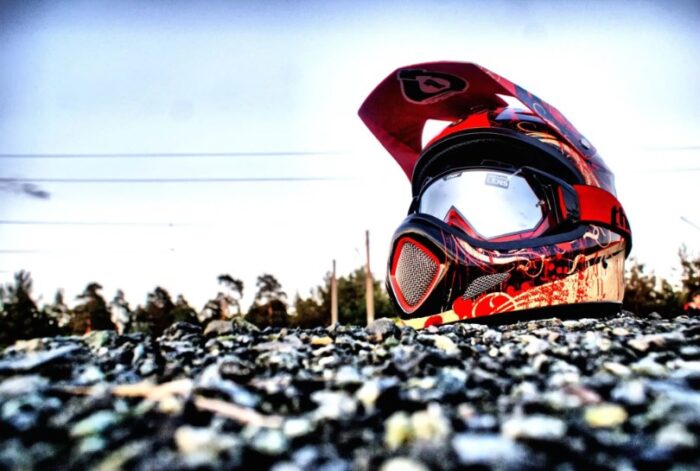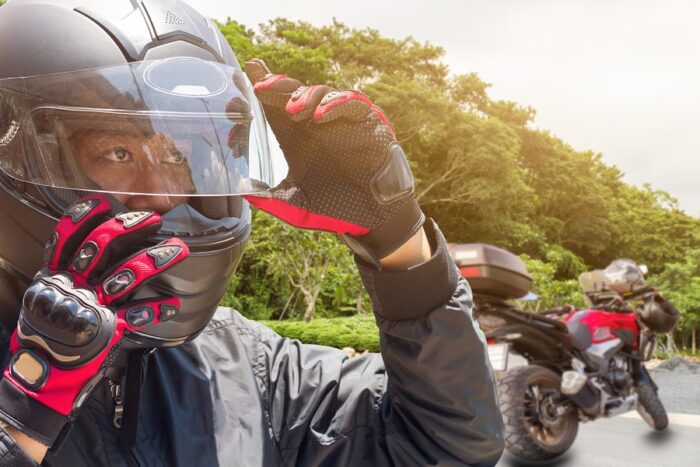
Riding a motorcycle can be an exhilarating experience, but it also comes with risks. One of those risks is hitting your head on the ground if you don’t wear a helmet. But just how tight should a motocross helmet fit? In this article, we will show you tips on how tight should a motocross helmet fit.
What are the different types?

There are many different types of motocross helmets, each with its purpose. To ensure a proper fit, be sure to try on several different ones before making a purchase. Here are some common types:
Open-Face Helmet
This style is popular for street or track riding because it’s comfortable and allows you to see around you. Most open-face ones have a padded liner and an adjustable chin strap.
Half-Shell Helmet
This type is popular for motocross because it offers more protection than an open-face helmet but is still comfortable to wear. Half-shell ones have a hard plastic outer shell that covers the entire head and a soft EPS inner liner. They usually have adjustable straps and a built-in face shield that can be removed for ventilation.
Full-Face Helmet
This type is best suited for dirt bike racing or off-road use. Full-face helmets have an all-enclosed design that protects your head from debris and rocks. They usually have a detachable face shield and adjustable straps.
Moto GP Style Helmets
These were designed specifically for motorcycle racing. They’re extremely protective and feature several features, such as visors and air vents, that are specific to motorcycle racing.
There are also modular helmets available that allow you to customize the fit and protection of your helmet.
What is the best way to care for my motocross helmet?

To keep your motocross helmet in good condition, follow these simple tips:
- refrain from wearing your helmet if it’s wet or hot
- clean your helmet with a soft, damp cloth every time you ride
- replace the cheek pads, liner, and shield if they start to wear down
- replace the helmet visor if it becomes scratched or torn
Proper Motocross Helmet Position
There are a few different ways to position your helmet for optimum protection. One popular way is to place it so that the chin strap rests comfortably against the neck, with the helmet pushed back slightly on the head. This position allows the rider to keep an eye on their surroundings while keeping their head and neck protected. Another popular option is to position the helmet so that the peak is pointing down towards the ground. This allows the rider to keep their head and neck protected while also preventing them from being distracted by the scenery around them.
When it comes to choosing the right helmet for your motocross riding, it is important to make sure that you select the correct size and shape. Your helmet should fit snugly but not too tight and should feature a flat front so that it does not interfere with your vision. Additionally, you should pay attention to the safety ratings of the helmet you are considering, as higher safety ratings usually mean that the helmet is more protective.
How tight should a motocross helmet fit?

When buying a motocross helmet, you want it to fit snugly so that it’s protective and comfortable at the same time. You don’t want the helmet to be too tight, however, as this may cause discomfort or even headaches. A good rule of thumb is to fit the helmet slightly tighter than you normally would your baseball cap. If it’s still too tight, go a size up. They can come in a variety of sizes, so it’s important to find one that fits well
What to do if your motocross helmet is too tight
If your motocross helmet is too tight, you may experience discomfort, fogging, and even a headache. Here are a few tips to help loosen your helmet:
- Warm up your helmet by riding for a few minutes with it on. This will help the plastic soften and make it easier to remove.
- Apply pressure to the front of the helmet from the inside. This will cause the helmet to expand and should make it easier to remove.
- Use a hair dryer to heat the back of the helmet and then use your fingers to work the plastic loosening it from its moorings. Remember to be careful not to burn yourself!
- If all of these tips fail, you may need to take your helmet to a professional to have it loosened.
How to Adjust Motocross Helmet Straps
The main reason why people adjust their motocross helmet straps incorrectly is that they don’t understand how to use them properly. The first step in adjusting your helmet strap correctly is to make sure that it doesn’t feel loose or too tight. This can be done by checking whether or not you can slide your finger into the gap between the strap and your chin guard when you have it on.
Next, loosen the strap if it is too tight and then pull it towards your forehead until it is snug. Loosen the strap again if it is too loose and push it down towards your chin. Finally, tighten the strap to the correct level.
It is also important to be aware of the correct size for your helmet strap. Many Motocross Helmets NZ come with adjustable straps, but it is always best to check with the manufacturer first.
If you are not sure how to adjust your helmet strap, it is best to consult a professional.
Conclusion
As a motorcyclist, it is important to make sure your helmet fits snugly so that you are as safe as possible while riding. That’s why you might find this article useful for your safety.








